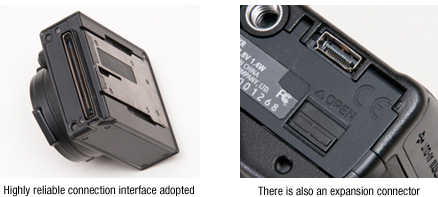Inside Story
Reliable connection and high-speed data transfer achieved

"With the GXR, the start of sales did
not mark the end of development; it
marked a new start for development."
(Satoru Kamakura)
Unlike simple lens changes, with the GXR the camera unit also includes the image sensor so data must be sent from the camera unit to the body. Consequently, it is necessary to have a reliable connection that can handle repeated attachment/removal and that can quickly and accurately transfer data. "The thing that took the most time was deciding the connection interface. We discussed the interface decisions with the software and other departments, and with factors such as expandability, transfer speed, and physical dimensions to consider, the investigations continued up until the last minute," explained Satoru Kamakura, electrical systems design leader from Design Group No. 2 in the Personal MultiMedia Products Company ICS Design Office. The connection interface utilizes a highly reliable connector that is also used on personal computers.
The placement of the electronic circuit boards also presented a challenge. "What in the past would have been a single circuit board had to be divided between the body and camera unit so it required even more ingenuity than usual to figure out how to install the circuit boards in the limited space available," said Kamakura. The small S10 camera unit had to also contain the zoom lens barrel so the circuit board was broken up in order to fit in the unit. "Since the power consumption of each camera unit is different, power control also required an approach not found in past models," he added. Reflecting on the fact that new units are coming in the future, Kamakura said, "Taking the GXR's future potential into account, we also provided a separate expansion connector for non-camera units and for connections to other equipment."

Where to draw the dividing line for image processing?

"We are doing software development
based on the premise that new units
other than camera units will be attached
in the future." (Takashi Maki)
"After the decisions were made on how to physically divide up the electronic circuit boards, we decided the range of image processing to be done by the body and the camera units," said Takashi Maki, software development leader from Design Group No. 3 in the Personal MultiMedia Products Company ICS Design Office. "Once the light is converted to an electrical signal, the data must be sent to the body, but it was difficult to determine the stage (after the image is created, after the data is compressed, etc.) at which this should be done. If the data is compressed, it can be transferred at high speed, but in order to display the images on the LCD monitor, it becomes necessary to send 30 images a second and repeatedly decompress them. This causes a time lag for image display so in the end we selected an interface that could send uncompressed data at high speed, and we decided to send the data as is," Maki explained.
Ease of use has been enhanced with new DIRECT screen functions enabling settings to be checked and changed. "On past models, the camera would decide the priority sequence for processing functions with overlapping settings, such as auto bracketing* and continuous shooting. This meant that, depending on the function that the user wanted to define, there were cases where it was necessary to separately redo settings. On the GXR's DIRECT screen, however, we always give top priority to the function that the user defined last," Maki continued.
- *Auto bracketing
With this function, when the shutter release button is pressed once, the camera takes multiple shots including exposure settings before and after the regular exposure.
Satisfying future expectations with firmware updates
As the information presented here indicates, both software development and future GXR development have been taken into account in the fine tuning and implementation of GXR plans. A particular point of interest for many users has been the use of a large image sensor, and people have been asking us: What kind of camera unit is coming next? "As is being done in the GR DIGITAL series, we will be providing new function firmware downloads for the GXR. We have made it possible for the body itself to evolve via such firmware updates issued when a new camera unit is released," said Maki. With both new camera units and firmware updates, the evolution of the GXR interchangeable unit camera system will continue. Next time we will take a look at what users are saying and at the future outlook.
- *Lens focal lengths in the text are all converted to 35 mm film camera equivalents.


